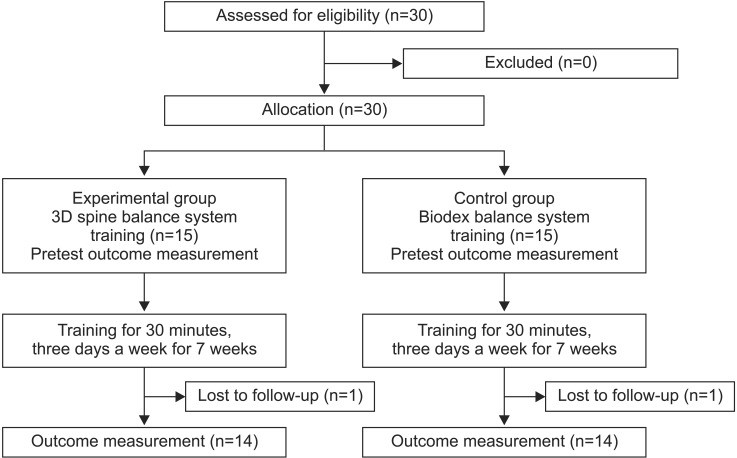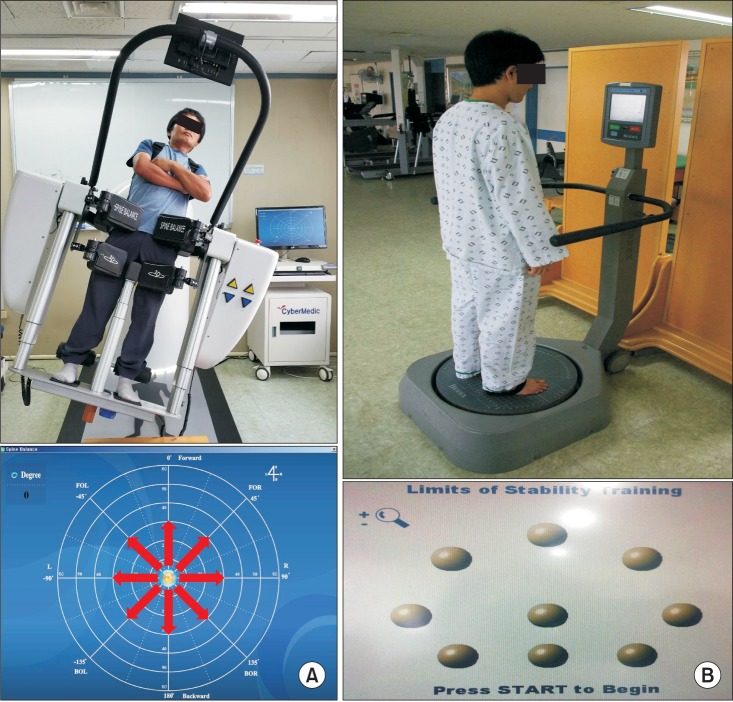Ann Rehabil Med.
2016 Dec;40(6):972-980. 10.5535/arm.2016.40.6.972.
Effects of 3-Dimensional Lumbar Stabilization Training for Balance in Chronic Hemiplegic Stroke Patients: A Randomized Controlled Trial
- Affiliations
-
- 1Department of Physical Medicine and Rehabilitation, Research Institute of Clinical Medicine of Chonbuk National University & Biomedical Research Institute of Chonbuk National University Hospital, Jeonju, Korea. mhko@jbnu.ac.kr
- KMID: 2371328
- DOI: http://doi.org/10.5535/arm.2016.40.6.972
Abstract
OBJECTIVE
To investigate the effects of the newly developed Spine Balance 3D system on the balance and gait abilities of hemiplegic stroke patients.
METHODS
Twenty-eight hemiplegic patients with chronic stroke were randomly assigned to an experimental (n=14) or control group (n=14). The experimental and control groups performed balance training by using the newly developed Spine Balance 3D system and the well-known Biodex Balance System 30 minutes per day, three times a week for 7 weeks. The Berg Balance Scale (BBS), 10-m walking test (10mWT), Timed Up and Go Test (TUG), Functional Reach Test (FRT), the Korean version of the Fall Efficacy Scale-International (KFES-I), trunk muscle strength and stability were evaluated before and after 7 weeks of intervention.
RESULTS
The 10mWT improved significantly (p=0.001) in the experimental group (using the Spine Balance 3D system) but not in the control group, and core muscle strength, which we checked using Spine Balance 3D system evaluation program, improved more in the experimental group as well. The results of the BBS, FRT, TUG, KFES-I, and Biodex Balance System evaluation program improved in both groups after 7 weeks of balance training.
CONCLUSION
We suggest that the newly-developed Spine Balance 3D system can be a more useful therapeutic tool for gait and dynamic balance rehabilitation in hemiplegic patients than a conventional 2D-based balance training system. A large-scale randomized controlled study is needed to prove the effect of this system.
Keyword
Figure
Cited by 1 articles
-
The Relations between Sitting Balance and Functional Recovery according to Characteristics of the Stroke Patients
Da-Sol Kim, Myoung-Hwan Ko, Yu Hui Won, Sung-Hee Park, Jeong-Hwan Seo, Gi-Wook Kim
Brain Neurorehabil. 2020;13(1):. doi: 10.12786/bn.2020.13.e2.
Reference
-
1. Jonsdottir J, Cattaneo D. Reliability and validity of the dynamic gait index in persons with chronic stroke. Arch Phys Med Rehabil. 2007; 88:1410–1415. PMID: 17964880.
Article2. Hahn J, Shin S, Lee W. The effect of modified trampoline training on balance, gait, and falls efficacy of stroke patients. J Phys Ther Sci. 2015; 27:3351–3354. PMID: 26696696.
Article3. Anson E, Rosenberg R, Agada P, Kiemel T, Jeka J. Does visual feedback during walking result in similar improvements in trunk control for young and older healthy adults? J Neuroeng Rehabil. 2013; 10:110. PMID: 24274143.
Article4. Lee JS, Lee HG. Effects of sling exercise therapy on trunk muscle activation and balance in chronic hemiplegic patients. J Phys Ther Sci. 2014; 26:655–659. PMID: 24926126.5. Hesse S, Bertelt C, Jahnke MT, Schaffrin A, Baake P, Malezic M, et al. Treadmill training with partial body weight support compared with physiotherapy in nonambulatory hemiparetic patients. Stroke. 1995; 26:976–981. PMID: 7762049.
Article6. Mayr A, Kofler M, Quirbach E, Matzak H, Frohlich K, Saltuari L. Prospective, blinded, randomized crossover study of gait rehabilitation in stroke patients using the Lokomat gait orthosis. Neurorehabil Neural Repair. 2007; 21:307–314. PMID: 17476001.
Article7. Eftekhar-Sadat B, Azizi R, Aliasgharzadeh A, Toopchizadeh V, Ghojazadeh M. Effect of balance training with Biodex Stability System on balance in diabetic neuropathy. Ther Adv Endocrinol Metab. 2015; 6:233–240. PMID: 26445646.
Article8. Hodges PW, Richardson CA. Contraction of the abdominal muscles associated with movement of the lower limb. Phys Ther. 1997; 77:132–144. PMID: 9037214.
Article9. Kim JH, Lee SM, Jeon SH. Correlations among trunk impairment, functional performance, and muscle activity during forward reaching tasks in patients with chronic stroke. J Phys Ther Sci. 2015; 27:2955–2958. PMID: 26504333.
Article10. Fujita T, Sato A, Togashi Y, Kasahara R, Ohashi T, Yamamoto Y. Contribution of abdominal muscle strength to various activities of daily living of stroke patients with mild paralysis. J Phys Ther Sci. 2015; 27:815–818. PMID: 25931737.
Article11. Jung K, Kim Y, Chung Y, Hwang S. Weight-shift training improves trunk control, proprioception, and balance in patients with chronic hemiparetic stroke. Tohoku J Exp Med. 2014; 232:195–199. PMID: 24646921.
Article12. Stevens VK, Bouche KG, Mahieu NN, Coorevits PL, Vanderstraeten GG, Danneels LA. Trunk muscle activity in healthy subjects during bridging stabilization exercises. BMC Musculoskelet Disord. 2006; 7:75. PMID: 16987410.
Article13. Kim NJ, Kim JS, Wang JS, Park JH, Choi JH. The effects of isometric trunk exercises and dynamic trunk exercises on gait in elderly people. J Phys Ther Sci. 2015; 27:1685–1689. PMID: 26180298.
Article14. Fenwick CM, Brown SH, McGill SM. Comparison of different rowing exercises: trunk muscle activation and lumbar spine motion, load, and stiffness. J Strength Cond Res. 2009; 23:350–358. PMID: 19197209.
Article15. Cook TM, Zimmermann CL, Lux KM, Neubrand CM, Nicholson TD. EMG comparison of lateral step-up and stepping machine exercise. J Orthop Sports Phys Ther. 1992; 16:108–113. PMID: 18796761.
Article16. Oliver GD, Di Brezzo R. Functional balance training in collegiate women athletes. J Strength Cond Res. 2009; 23:2124–2129. PMID: 19855341.
Article17. Gusi N, Carmelo Adsuar J, Corzo H, Del Pozo-Cruz B, Olivares PR, Parraca JA. Balance training reduces fear of falling and improves dynamic balance and isometric strength in institutionalised older people: a randomised trial. J Physiother. 2012; 58:97–104. PMID: 22613239.
Article18. Saeys W, Vereeck L, Truijen S, Lafosse C, Wuyts FP, Heyning PV. Randomized controlled trial of truncal exercises early after stroke to improve balance and mobility. Neurorehabil Neural Repair. 2012; 26:231–238. PMID: 21844283.
Article19. Seo SB, Kim DH, Jung HC. The effect of 3-D spine stabilization training on trunk muscle strength and body composition in elderly. J RWEAT. 2015; 9:45–51.
- Full Text Links
- Actions
-
Cited
- CITED
-
- Close
- Share
- Similar articles
-
- The Effects of Balance Training Using Balance System in the Hemiplegic Patients
- Effects of Treadmill Gait Training According to Different Inclination on Postural Balance in Patients with Chronic Stroke
- The Effects of Additional Balance Training in Subacute Hemiplegic Stroke Patients
- Effects of the Balance Control Training in Chronic Hemiplegic Stroke Patients
- The Effects of Shoulder Slings on Balance in Patients With Hemiplegic Stroke



